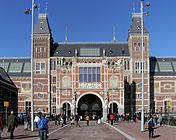For long this painting by Dirck Craey in the collection of the Rijksmuseum Amsterdam was considered to be a portrait of Jan van Riebeeck.
I include excerpts from a recent article on the painting:
For a long time Jan van Riebeeck was a symbol without a face. His portrait had been forgotten until 1884, when a series of 25 portraits, purported to be from the Van Riebeeck family, was donated to the Rijksmuseum. One painting was immediately deemed to be an authentic depiction of Van Riebeeck, seemingly confirmed by both its provenance and the inscription on the back.
Except the man in the painting is not Jan van Riebeeck. Doubts about the portrait’s authenticity had emerged soon after its discovery, and by 1912 another portrait from the same collection was identified as being the authentic Van Riebeeck. Still, even in 1952 on occasion of the Jan van Riebeeck tercentenary the Rijksmuseum confirmed the identity of the first portrait. But it was only in 1985 that the attribution of the first Van Riebeeck painting was firmly rejected in favour of the second. In the meantime the wrong painting had become the standard type for depictions of Van Riebeeck on South Africa’s banknotes, coins, stamps, and even official statues.
But who then is the man in the first painting? The portrait is now identified as likely depicting one Bartholomeus Vermuyden. Because of an initial misidentification and perpetuated by nationalist desire for an attractive symbol, Vermuyden, despite no known connection with South Africa, unwittingly became South Africa’s most notorious nationalist symbol centuries after his death. His painting is perhaps one of the most reprinted works in the collection of the Rijksmuseum.
Similarly the portrait of the sitter’s wife was interpreted as a portrait of Marie de la Quellerie, Jan van Riebeeck’s wife.
Of Bartholomeus Vermuyden not very much is known. He lived from c. 1617-1650, and was a military man, first in England under Oliver Cromwell, and from 1649 in the Dutch infantry as a captain until his death in August 1650.





